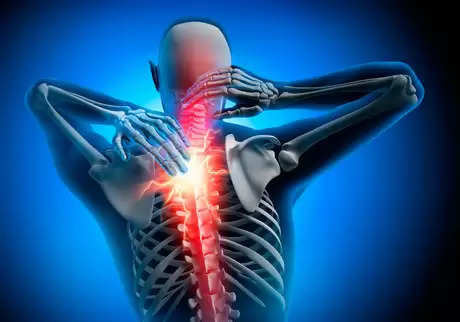Pain-Free Living: Tips to Beat Musculoskeletal Disorders
Dr Suman Singh, Emeritus Professor, MPUAT, Udaipur
Bipasha Bhomick, Ph. D. Scholar, MPUAT, Udaipur
Have you ever felt pain in your muscles, joints, or bones? If so, you might have experienced a musculoskeletal disorder. These disorders affect the muscles, bones, and joints, making it hard to move and do everyday tasks. Let's learn more about what musculoskeletal disorders are, their causes, symptoms, and how to manage them.
What Are Musculoskeletal Disorders?
Musculoskeletal disorders, often called MSDs, include a wide range of conditions that affect your muscles, bones, and joints. Common examples are Carpal Tunnel Syndrome, Tendinitis, Bursitis, Lower Back Pain, Sciatica, Epicondylitis, Spondylosis, Herniated Disc, Osteoarthritis and Osteoporosis etc. These disorders can happen suddenly due to an injury or develop over time from repetitive movements or poor posture. MSDs can affect people of all ages, but they are more common as we get older.
An example of a musculoskeletal disorder (MSD) resulting from a sedentary lifestyle is lower back pain. Prolonged sitting, often in poor posture, can lead to weakened core muscles, increased pressure on spinal discs, and reduced blood flow to the lower back, all contributing to chronic pain and discomfort. This is particularly common in individuals who spend long hours working at a desk or using digital devices without regular breaks or proper ergonomic support.
Causes of Musculoskeletal Disorders
There are many causes of musculoskeletal disorders. One major cause is physical injury, such as a fall or accident that damages bones or muscles. Repetitive motions, like typing or lifting/lowering heavy objects, can also cause these disorders. Poor posture, especially when sitting or standing for long periods, puts extra strain on muscles and joints, leading to pain and discomfort. Additionally, some MSDs are linked to aging and the natural wear and tear on our bodies over time.
Watch out for Symptoms of MSDs
Symptoms of musculoskeletal disorders vary depending on the specific condition but often include pain, stiffness, and swelling in the affected areas. You might also notice a limited range of motion, making it hard to bend, stretch, or move certain parts of your body. Sometimes, there can be a feeling of weakness or numbness in the muscles. If you experience these symptoms, it’s important to see a doctor to find out what’s causing them and how to treat them.
Managing and Preventing Musculoskeletal Disorders
Musculoskeletal disorders, often stemming from repetitive strain or acute injury, are not just a matter of physical discomfort—they can significantly impair a person's quality of life, limit productivity, and place a substantial burden on healthcare systems. Addressing these disorders is crucial for maintaining overall well-being and ensuring a healthy, active lifestyle.
Controlling musculoskeletal disorders (MSDs) involves a combination of preventive measures, lifestyle changes, and proper management techniques. Here are some strategies:
- Ergonomics:
- Ensure proper workstation setup with ergonomic chairs and desks.
- Position computer screens at eye level to avoid neck strain.
- Use supportive equipment, like keyboard trays and footrests.
- Regular Exercise:
- Engage in regular physical activity to strengthen muscles and improve flexibility.
- Incorporate exercises that target the core, back, and other areas prone to strain.
- Stretch regularly, especially if sitting for long periods.
- Taking breaks and stretching during repetitive tasks can prevent injuries.
- Posture:
- Maintain good posture while sitting, standing, and lifting.
- Avoid slouching or leaning forward excessively.
- Frequent Breaks:
- Take short breaks every hour to stand, stretch, and move around.
- Perform simple stretching exercises to relieve tension.
- Healthy Lifestyle:
- Maintain a healthy weight to reduce stress on joints and muscles.
- Eat a balanced diet rich in nutrients that support bone and muscle health.
- Proper Lifting Techniques:
- Use proper techniques when lifting heavy objects—bend at the knees, keep the back straight, and use the legs to lift.
- Use of Supportive Devices:
- Use wrist supports, lumbar rolls, or other assistive devices if needed.
- Workplace Wellness Programs:
- Many organizations carry out regular sessions on workplace wellness, participate in such workplace wellness programs that focus on physical health and ergonomics.
- Education and Training:
- Stay informed about the risks and prevention of MSDs.
- Attend training sessions on ergonomics and safe work practices.
- Medical Consultation:
- Seek medical advice if experiencing persistent pain or discomfort.
- Follow prescribed treatments or physical therapy regimens.
By implementing these strategies, individuals can significantly reduce the risk of developing musculoskeletal disorders and improve their overall musculoskeletal health.
"Addressing musculoskeletal disorders is crucial for the young generation, as early prevention and intervention can set the foundation for a lifetime of physical health, productivity, and overall well-being. By fostering healthy habits now, we can prevent chronic pain and mobility issues that could hinder their future potential and quality of life." - Prof. HemuRathore Head, RMCS Dept, CCAS, MPUAT, Udaipur
The Importance of Early Intervention
Early diagnosis and treatment of musculoskeletal disorders can prevent them from becoming worse. If you notice any persistent pain or discomfort in your muscles, joints, or bones, don’t ignore it. Seeing a healthcare professional early can lead to more effective treatment and a better quality of life.
To sum up, musculoskeletal disorders are common and painful conditions that affect many people. Managing MSDs often involves a combination of approaches.By understanding the causes, symptoms, and ways to manage these disorders, one can take steps to protect muscular-skeletal health. Remember, simple practices like exercising regularly, maintaining good posture, and seeking early medical advice can make a big difference in preventing and managing these disorders. Take care of your body, and it will take care of you.
To join us on Facebook Click Here and Subscribe to UdaipurTimes Broadcast channels on GoogleNews | Telegram | Signal



